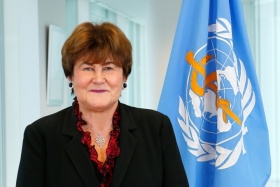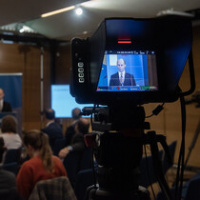Tests, masks, scenarios: we asked WHO on the current situation
Who should get tested, when should the test take place and what type of test should be applied according to the World Health Organization’s recommendation? Can we expect WHO in the near future to recommend mask wearing in public? Which are the models, scenarios that WHO considers realistic regarding the evolution and duration of the epidemic and which are the most likely? When can we expect a vaccine suitable for mass inoculation? To answer these questions, mta.hu contacted dr. Zsuzsanna Jakab, Deputy Director-General of the World Health Organization via e-mail, who provided us with the following information on April 17.
- Who should get tested, when should the test take place and what type of test should be applied according to the World Health Organization’s recommendation?
Why testing is important
 Dr. Zsuzsanna Jakab
Dr. Zsuzsanna JakabSince the very beginning of the outbreak, WHO encouraged all countries to find, test, isolate and treat every case and trace every contact to control transmission early. Evidence shows that where there has been early action and implementation of comprehensive public health measures – including rapid testing – countries have been able to slow down or suppress the spread of COVID‑19 below the threshold at which health systems become unable to prevent excess mortality.
Who should get tested and when
- WHO has issued a set of laboratory testing guidance documents, to support the countries in building and developing their testing capacities and strategies.
- According to our guidance, the decision to test a suspected case of COVID-19 should be based on the case definition (WHO issued specific definitions to help countries in their global surveillance for COVID-19), clinical and epidemiological factors and linked to an assessment of the likelihood of infection.
- Countries need to implement prioritized testing strategies depending on the transmission scenario they experience from no case to community transmission. Depending on the intensity of transmission, the number of cases and laboratory testing and surge capacity, it may be necessary to prioritize who gets tested according to health objectives.
- Countries and communities must increase their capacity to identify suspected cases of COVID‑19 quickly based on the onset of signs or symptoms. It is also essential to identify and trace contacts, and quarantine and monitor them for 14 days.
- In contexts where testing is not possible, confirmation of COVID 19 may instead be based on reported symptoms or signs.
What type of test should be applied
- Ideally, PCR testing gives the most accurate results. As Dr Mike Ryan said on 10 April: “Governments need to focus on PCR-based testing or any form of testing that detects active infection.”
- At present, based on current evidence, WHO recommends the use of these new point-of-care immunodiagnostic tests only in research settings. We are working very hard to validate some of those tests, through our expert networks and we will update our guidance when necessary. More here.
- WHO has listed the first two diagnostic tests for emergency use during the Covid-19 pandemic. The move should help increase access to quality-assured, accurate tests for the disease. It also means that the tests can now be supplied by the United Nations and other procurement agencies supporting the COVID-19 response.
2. Which are the models, scenarios that the WHO considers realistic regarding the evolution and duration of the epidemic and which are the most likely?
- We cannot make predictions regarding the evolution and duration of the pandemic, but we can say that the course of the pandemic will be determined by the actions that countries take.
- For now, our focus is on stopping this virus and saving lives.
- WHO is advising countries on actions they can take for several scenarios – first case, first cluster, and first evidence of community transmission. The basic actions in each scenario are the same, but the emphasis changes depending on which transmission scenario a country is in.
- WHO published an update to the COVID-19 strategy here to provide guidance for countries in their public health response to COVID-19 and phased transition from widespread transmission to a steady state of low-level or no transmission.
3. According to information at the WHO’s disposal, when can we expect a vaccine suitable for mass inoculation and when will it be available globally?
- There is no vaccine against COVID-19 at the moment and usually, it can take several years to develop one.
- The first vaccine trial has begun just 60 days after the genetic sequence of the virus was shared by China. This is an incredible achievement. As of today, three vaccines have already started clinical trials, more than 70 others are in development. See landscape of COVID-19 candidate vaccines (under R&D latest reports for vaccines).
- We are working very closely with major donors and partners, including the World Bank and CEPI and other agencies at global level to invest in vaccine development. In the meantime, we can save lives with therapeutics and without disrupting the resources we need to invest in national health capacity.
- A Solidarity trial for vaccine development is currently being established, in addition to the one for therapeutics. This large, international, multi-site, individually randomized controlled clinical trial will enable the concurrent evaluation of the benefits and risks of each promising candidate vaccine within 3-6 months of it being made available for the trial. See Solidarity Trial’s protocol for vaccines here.
4. Can we expect WHO in the near future to recommend mask wearing in public and to recommend the more rigorous protection of medical staff?
On masks
- We understand that some countries have recommended the use of both medical and non-medical masks in the general population to prevent the spread of COVID-19.
- There is currently insufficient evidence for WHO to make a recommendation either way, for the use or non-use, of non-medical masks. WHO continues to consult with international experts and studies on this matter. As new evidence about mask and non-medical masks emerges, WHO will update guidance accordingly.
- On 6 April, WHO issued guidance and criteria for countries to use in making that decision. If people wear masks, they should use them safely and properly as per WHO’s advice to public on masks.
- We encourage countries that are considering the use of masks for the general population to study their effectiveness, so we can all learn from their experience.
- In health care facilities, WHO continues to recommend the use of medical masks, respirators and other personal protective equipment for health workers.
- In the community, we recommend the use of medical masks by people who are sick and those who are caring for a sick person at home.
- Masks should only ever be used as part of a comprehensive package of interventions.
On PPE for health care workers
- Since the beginning of the outbreak, WHO’s priority is that frontline health workers are able to access essential health supplies, including personal protective equipment, including medical masks and respirators.
- The COVID-19 pandemic continues to create an acute shortage of essential supplies, including personal protective equipment, diagnostics and medical equipment. We call on countries to work with companies to increase production; to ensure the free movement of essential health products; and to ensure equitable distribution of those products, based on need.
- WHO is regularly updating its advice and guidance pack for health workers. See WHO advice (risk communications) and technical guidance for health workers.
- To gauge the need for supplies/equipment and health work force requirements during the COVID-19 pandemic, WHO has developed a suite of complimentary surge calculators here.
5. What is the WHO’s long term strategy to avoid similar epidemics in the future and which are the most important steps to take in this regard?
- WHO has been working for years on how to be better prepared to health emergencies. We know that preparedness is crucial for all countries, as the damages caused by a virus in countries with weaker health systems can be tremendous.
- We play a central role in working closely with countries to ensure compliance with the requirements of the International Health Regulations (2005) to build and strengthen national capacities for health emergency preparedness, and to ensure global health security.
- WHO is advocating for broader political engagement at the interface of health, foreign policy and finance to enable countries to develop common positions and support multisector, all hazard preparedness plans. It would lead to concrete steps towards keeping the world safe, protecting economies and connecting nations in preparing for future health emergencies.
- Regarding COVID-19, WHO is working 24/7 at the three levels of the organization and through our global networks of experts to provide rational and science-based public health guidance and recommendations so that countries can be better prepared to respond to the outbreak.
- We issued our first comprehensive package of technical guidance online early January with advice to all countries on how to detect, test and manage potential cases, based on what was known about the virus at the time.
- Although COVID-19 presents an acute threat now, it is absolutely essential that countries do not lose this opportunity to strengthen their preparedness systems.
- WHO strategic preparedness and response plan outlines the public health measures that the international community stands ready to provide to support all countries to prepare for and respond to COVID-19. Links to the plans.
mta.hu contacted the World Health Organization earlier. Our questions, sent on April 8, were addressed by Richard Peabody (Team Leader Infectious Hazard Management at WHO/Europe.)
One of the conundrums of the COVID-19 progression around the globe is the huge differences in infection numbers in different countries. The spread of a disease around the world is a complex process that depends on travel patterns and links between countries. By this measure higher infection levels could be seen as an index of a country’s connectedness in the global economy. However the actions of countries and individuals remain key to containing an outbreak. Although the countries of Central and Eastern Europe that have so far been less affected by the coronavirus pandemic are at an earlier stage of the of the pandemic and will likely see peak cases at an later date, they also show the importance of the timely application of widespread testing, contact tracing, isolation of confirmed cases and quarantining of contacts, said Dr Richard Pebody, Team Leader Infectious Hazard Management at the WHO/Europe. While the virus was able to make serious progress in western Europe and the United states early on, other countries were able to learn lessons from their experiences and move quickly with containment measures.




